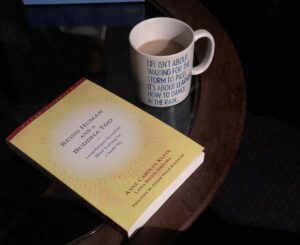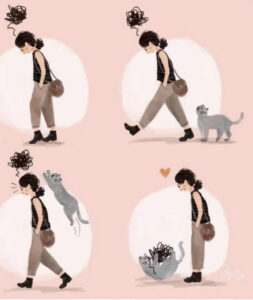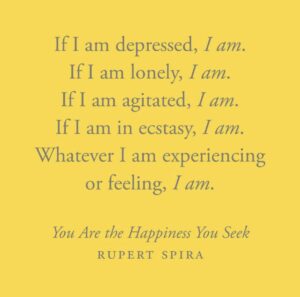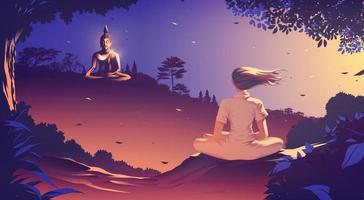Awake early this morning; and so I start my day of writing in the (pitch) dark. There is a synergy in this situation with writing – awakening and the dark; being a buddha and a human being. With a history of insomnia, such early morning awaking does not trouble me…in fact I enjoy these early morning hours: knowing I am up and about when no-one else is (although given the house lights currently on in my street, that solitude is a fantasy). But I do know sleeplessness is a barometer of my overall well-being: I am processing. A background mumbling that is currently outside my grasp of understanding, and yet it is known, bodily. There is confusion AND wisdom, both / and in my responses to insomnia today. I reach for some dharma as companion in dark moments (literal, emotional), and right now that book is Anne Klein’s “Being Human and a Buddha too”.
 I am often left dumbfounded on this path of human being how when there is something to be learnt, life points to it…continually and repeatedly, until I take the hint! Synchronicity if you will. Like many I have been speaking with in the past few weeks, the transition into autumn and the winter months isn’t always an easy one: and it is easy to get fixated on the dark, missing how it is “backlit by completeness” (to use Klein’s words). And so, when different sources remind me of the completeness, there has been an invitation to stand back a bit; to see that the dark is not solid, it is actually transparent.
I am often left dumbfounded on this path of human being how when there is something to be learnt, life points to it…continually and repeatedly, until I take the hint! Synchronicity if you will. Like many I have been speaking with in the past few weeks, the transition into autumn and the winter months isn’t always an easy one: and it is easy to get fixated on the dark, missing how it is “backlit by completeness” (to use Klein’s words). And so, when different sources remind me of the completeness, there has been an invitation to stand back a bit; to see that the dark is not solid, it is actually transparent.
I was recently listening to an interview with Buddhist author and translator Karl Brunnhölzl. One “call to wake-up” I have been touched by, Brunnhölzl was explaining some teachings associated with the view of Vajrayana Buddhism – that we are already awake and complete, we just don’t see it because of layers of obscurations. Now, I know this; and yet the words he used, the way he said it hit deep in a very practical way. “Rather than working on a buddhanature, we must work on our human nature”. This is the difference offered by the Vajrayana view – we don’t NEED to work on becoming a buddha – that IS our inherent state. The path, therefore, is to “unobscurate” if you like. When I started reading Klein’s book just a day later, these words from her introduction seemed to be pointing out the same message…
“Wholeness and connection are central to our existence. But we rarely live as if they are. Our unwieldy sense of separateness is at the core of our suffering. How to repair this is the main lesson we humans need to learn”
…a second call to wake up!
As I say, I have heard these teachings over and over on the Buddhist path. All Buddhist schools underline the ability to wake up and realise our Buddhanature. The main call from the Vajrayana, a system of teachings I have been practicing for four years now, is that this awareness is not a potential but rather we are already awake. We have simply lost the connection to the ground of wholeness. As Klein explains “There is no barrier between ordinary and awakened conditions…humans and buddhas are simply different ways of arising from the general ground of being….Right from the start, the state of being human holds intimations of awakening, even as it obstructs that very thing”
There are parallels with the path I have taken as a psychotherapist. Trained in the humanistic tradition, I aligned with the notion that we are fundamentally good and just need the right kind of support to fulfil that wholeness of being. We are on a journey of unfolding, of becoming. The more committed I have become to weaving together my therapy practice and my buddhist practice, the more I have ventured into transpersonal working and that view of healing. We are already whole, we are already “there”…we simply get caught up in the knottiness of our human being and lose sight of our fundamental okayness. Knots and ease.
“Wholeness…is about not getting lost in the drama in front of us that we forget a deeper ground that holds everything. The earth we stand on holds us all. The passion for wholeness blazingly recognises the multiplicities it contains”.
Trusting our buddhanature, we can turn to the knots. Klein suggests, “at their best, spiritual…psychological systems provide beacons toward wholeness; they are healers of separation”. We might even call psychotherapy a turning toward the knots: understanding them, experiencing how they bind us, examining the stories that keep us bound: as Brunnhölzl remarked, working on our human nature.
Being human is not plain sailing, or as Klein says “wholeness is not sameness. Our lived experience is infinitely variable” . To use the metaphor of ocean and waves, the ocean upon which we sail is going to have its up and downs, I know my life does! The trap is to take the animation of life personally…the sea is rough because “I am unloveable, I am not good enough, I deserve it” (delete as appropriate or supply your own personal version). “The ocean is home to infinite waves and ripples, the nature of all of them is water. Our personal wholeness is home to infinite waves of experience we do or do not want. Yet all of this occurs within the scope of experience. And all experience has the nature of knowing – some kind of awareness underlies every part of experience”.
Clients often report their frustration at falling foul to the same patterns, getting tripped up by, bound within, the same knots – especially those who have been in therapy for a while and have gained great insight into their propensities. One client said to me recently “why do we have to do the BS?”, referring both to the stickiness in a pattern AND the looking at it together in the therapy. A transpersonal therapy doesn’t ignore the knots. It views the knottiness as a part of our wholeness, our brilliance.
 I do understand this frustration. From our place of pain (on repeat), we see “me”, “knot”, and the place of ease as BEYOND the knottiness, the BS. But in the Buddhist view, and certainly the Vajrayana, “Me” / “knot” / “buddha” are no different. The knots are the display of our completeness and non-separation. Movement along the path is coming to realise there is no escape from pain – that is being human – but rather recognising our true nature shines through the knots.
I do understand this frustration. From our place of pain (on repeat), we see “me”, “knot”, and the place of ease as BEYOND the knottiness, the BS. But in the Buddhist view, and certainly the Vajrayana, “Me” / “knot” / “buddha” are no different. The knots are the display of our completeness and non-separation. Movement along the path is coming to realise there is no escape from pain – that is being human – but rather recognising our true nature shines through the knots.
“Instructions on practice and practice itself…reveal that [the] ground is actually a state that exists simultaneously, if secretly, with all the limitations that create the human-buddha dichotomy in the first place. Only a wisp separates buddhas and humans. This sense of separation from our birthright of wholeness yields pain, restlessness, and dissatisfaction”
And what IS the practice?
It is knowing our experience, feeling it vividly
AND falling back into the knowing itself – this is vaster than the knottiness of our pain.
 Klein cites the work of “micro-phenonmenologist” Claire Petitmengin “Most of the time, we are cut off from ourselves, from what vibrates and lives within us, and this disconnection has catastrophic consequences in all areas of existence. Retrieving contact with our experiences is the pre-condition that would allow the regaining of our lucidity, our dignity and courage”.
Klein cites the work of “micro-phenonmenologist” Claire Petitmengin “Most of the time, we are cut off from ourselves, from what vibrates and lives within us, and this disconnection has catastrophic consequences in all areas of existence. Retrieving contact with our experiences is the pre-condition that would allow the regaining of our lucidity, our dignity and courage”.
I’ve yet to share a third “call to wake up”. In the same series of interviews that spoke with Brunnhölzl, Buddhist teacher Tim Olmsted talked about “direction” on the Buddhist path. Technically, it was the first of these calls to wake up, but I only now see its weight in light of the voices of Klein and Brunnhölzl. Direction, where am I headed? What am I doing here? How does this path infuse my being, my waking hours? As a bodhisattva, I have vowed to be of service to all beings in their own path of “waking up”. My therapy work, being a supervisor, working with trainees ALL contribute to that AND YET, being a bodhisattva is full time, not just during “shop hours”. How am I showing up as a friend, a daughter, a wife, a colleague…how am I showing up on the cushion in my meditation and my Ngondro practices? For my sangha? There are so many aspects of knottiness through these domains. The call to “direction” is that commitment to waking up; but more than that, it is seeing the awakening present now, in each moment of knottiness.
Klein’s book is – valuably – autobiographical. And like me she had to face the question “Do you believe you can awaken in this lifetime?”. She adds “I believed it doctrinally…but seeing THIS is part of me NOW, and not in some distant time but SOON, was a wholly different matter”. This is a common discussion point with my sangha friends. We “get it”…but can we really get it? Does it really infuse our hours of practice? Many of the Vajrayana teachings point to the importance of devotion: not in the Western way of thinking, but rather seeing “Confidence, trust, and commitment are essential” . From the view of friends and family, I DO look to be a committed practitioner – but my discipline is not to be confused with “commitment” in the context of vajra devotion – do I have faith that I am awake, and is the totality of my being taking that into my practice sessions? So often I can fall into the view of “Me”, and the “knot” and awakening beyond: practice as a cause of awakening rather than practice as experiencing my awakenment.
Klein reminds us that “on a personal level, there are simple ways to feel more complete. Walking in the woods. Looking at the sky. Sitting quietly with dear friends. In every case, feeling safe in such a larger place is healing”. Relaxation is the key; releasing those constrictions, those bodily held echoes of our “BS” beliefs about who we are / are not. Allowing ourselves to be fully who we are. We also get opportunities when we are shifting to new roles, new identities. Klein shares a beautiful vignette remembering a transition from being a non-reader to becoming a reader, one I can relate to not only in my experiences of learning a new language, but also on the path to becoming a therapist. “Once I relaxed into the truth [of the new] it was easy to go on. Relaxing makes us more whole, more available to our knowing. The same is true as we move back and forth from our ordinary human experience to more awakened states”. I shared some of this view with trainees this week, hoping my encouragement to trust their human being, its wholeness (knots and all!). Knowing our edges, oscillating back and forth, taking the brakes off, letting go. “Learning to get out of our own way is the challenge” acknowledges Klein. This makes me think of how Chögyam Trungpa, Buddhist meditation master, invites a practice of working with the boundaries as we tip back and forth between the knottiness and clarity aspects of mind.
And yet personally, I have found it of great benefit to have a path that incorporates a system of teachings and instructions toward practice: a framework to understand my experience. As Klein points out “many religious traditions have narratives of wholeness that existed before variety was born, before separateness emerged, before there was light…..The boundary between uninterrupted vastness and the onset of variety is, after all, the moment of creation. The impulse to inquire into this process is at the heart of science and the pulsing centre of spiritual, psychological, and phenomenological inquiry”. I am grateful to have found a framework of practice that spans those three; and especially the opportunity to integrate the “map” of the enneagram with the GPS technology of Buddhist practices. Buddhism eloquently sets the view of inherent awareness, the enneagram sets out how we have “fallen” from that wholeness, refracting through 9 different prisms of human being. Buddha AND human.
As an enneatype Six, I see my path of working through the knots of doubt, and the associated strategies that attempt to make ground in the groundless of uncertainty. Mistrust in buddhanature expresses itself in human form with planning and control to combat existential anxiety. If I can find the courage to be; if I can feel the fear coursing through my body that tempts me to contract and open anyway, that is fear becoming fearlessness. There is also Six doubt that manifests in what Claudio Naranjo (Gestalt therapist and enneagram lineage holder) calls “spiritual stuttering”: a tendency to doubt the glimpses of buddhanature I am seeing through the knots. The enneagram holds the bodily experiencing, over to Klein again: “lived experience and cognitive understanding are distinctive and mutually enriching ways of knowing”.
There is a phrase in the Buddhist dharma “all instruction is but a finger pointing to the moon; and those whose gaze is fixed upon the pointer will never see beyond. Even let him catch sight of the moon, and still he cannot see its beauty.”
I often share this with the trainee therapists I work with. Theory is powerful. We need ideas and concepts to frame our work – like a trusted rope that lowers us down into experience. The error is to confuse the theory FOR experience. Learn the theory to let go of it. Klein came to know she “would have to connect what I “knew” about Buddhism with my own real-time sense of things” and adds “being willing to leave the safe haven of ideas for the messier area of experience was part of the challenge. I learned that I liked the creative space in which knowing and wondering flow forward together”. Staying with the questions, not always searching for answers.
I will leave a more complete exploration of how the Vajrayana and the enneagram have more in common with alchemical transmutation than therapeutic transformation for another occasion; but for now I want to round off with how Klein segues into the main body of her text. Describing a moment of realisation, Klein shares “there was no separation between knowing and what I knew; knowing and known were equally part of the blue air and water, the whole horizon felt as intimate as it was vast”. This is “the big reveal” within the Buddhist dharma: the non-dual view that nothing happens outside of consciousness. “Wisdom is present in every mind and body….not knowing ABOUT something else, it is sheer knowing, seeing itself…everything we experience is in the field of our knowing. There is no “out there” beyond that”.
Klein dangles a carrot for me to read on…
“Wisdom suffuses the entire human body and mind and distils the elements that transform ordinary flesh and blood into a body of wisdom”
Another call to wake up, but I would like more sleep so I plan to take this metaphorical option tomorrow morning!!

